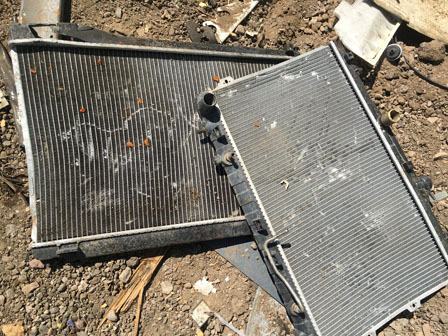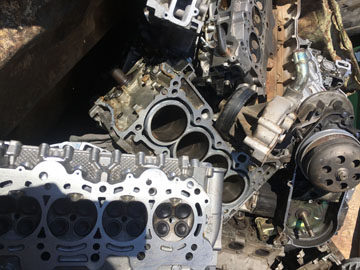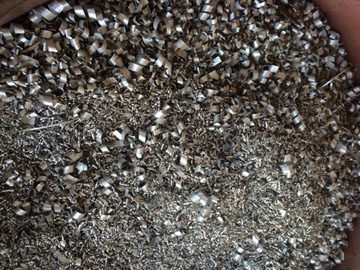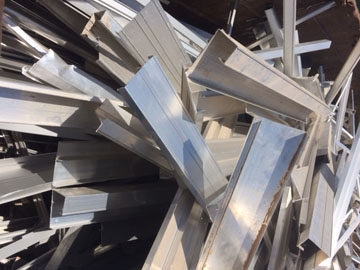Aluminum Recycling Center Near Me
I Buy Scrap Recycling is a top buyer of all types of scrap aluminum products. Our aluminum recycling center grades and process all types of scrap aluminum including all the products listed below.
Scrap Aluminum Insured Wire
Scrap aluminum insulated wire is beginning to take the place of commercial grade copper MCM. It is used primarily in commercial applications. Like MCM insulated aluminum wire will have individual strands of wire where the aluminum strand is larger than a pencil lead. Aluminum insulated wire is much lighter than MCM copper but like copper it is very rigid inside the plastic jacketing making it difficult to work with.

Painted Aluminum
It is very common for aluminum to come anodized from the factory. Scrap painted aluminum is a grade below clean aluminum scrap metal. The best way to know if aluminum has been painted is the scuff the surface with a product such as sandpaper and see if the color beneath is the same as the exterior color.
Typical usages; Aluminum siding
How To Identify Painted Aluminum?
Very light in weight, has paint on it, does not stick to a magnet, does not rust, does not throw a spark when a grinder hits it.

Contaminated Painted Aluminum
Contaminated painted aluminum scrap differs from painted aluminum. It is considered contaminated when there is metal, plastic. or other times attached to the painted aluminum. Contaminated materials are considered contaminated even if they have just a trace of another material on them. Contaminated materials are always going to be worth a fraction of what non- contaminated materials are worth.
Aluminum 6061
Scrap aluminum solids are pieces of aluminum that are characterized by bars, or spherical shapes. They are considered aluminum solids because they are solid all of the way through the material. It is easy to spot aluminum solids just by looking at the end of the material.
Typical usage; Manufacturing, Aircraft Construction.
How To Identify 6061 Aluminum?
Very light in weight, will have a 6061 stamped on it, does not stick to a magnet, does not rust, does not throw a spark when a grinder hits it.
Contaminated Aluminum 6061
Contaminated scrap aluminum 6061 will have items such as glue, metal, screws, caulking, glass etc. attached to the item. Contaminated materials are considered contaminated even if they have just a trace of another material on them. Contaminated materials are always going to be worth a fraction of what non- contaminated materials are worth.
Aluminum Radiators
Scrap aluminum radiators are typically very light weight and are fast replacing all types of aluminum/copper radiators in different practical applications. Aluminum radiators will have either large or small fins on the depending upon their usage, and will be silver in appearance
Typical usage; Car & Truck Radiators, AC Condensors,
How To Identify Aluminum Radiators?
Very light in weight, usually rectangular in dimension, will have small or large fins, does not stick to a magnet, does not rust, does not throw a spark when a grinder hits it.

Aluminum Radiators Contaminated
Contaminated scrap aluminum radiators are classified as contaminated if they have any trace of materials other than aluminum on them. This means no metal, metal screws, plastic, caulking etc. Contaminated materials are always going to be worth a fraction of what non- contaminated materials are worth.

Aluminum Cans
There are two easy ways to identify an aluminum cans versus a metal can. If you touch a magnet to a metal can it will stick, but it will not stick to an aluminum can. Second, metal cans are much heavier than aluminum cans.
Typical usages; Aluminum cans are widely used for both alcoholic beverages and non-alcoholic beverages.
How To Identify Aluminum Cans?
Very light in weight, does not stick to a magnet, does not rust, does not throw a spark when a grinder hits it.
Aluminum Auto Wheels
Scrap aluminum wheels differ from chrome wheels and are paid on a different pay scale from their shiny counterparts. Aluminum wheels typically have a dull finish to them. To get the highest value for your wheels always make sure to take the wheel weights off of them, and pull out the rubber stems.
Typical usage; automobile wheels, truck wheels and large bus wheels.
How To Identify Aluminum Auto Wheels?
Lighter in weight than their steel counterparts, does not stick to a magnet, does not rust, does not throw a spark when a grinder hits it.

Aluminum Auto Wheels Contaminated
Contaminated scrap auto wheels are categorized as contaminated if they have lead weights, metal weights, rubber stems, metal stems or rubber attached to the aluminum wheel.
Typical usage; Golf cart Wheel, automobile wheels, truck wheels, semi tractor wheels and large bus wheels.
Chrome Aluminum Auto Wheels
Scrap chrome plated wheels differ from aluminum wheels and are paid on a different pay scale from their dull or painted counterparts. Scrap chrome aluminum wheels typically have a shiny finish to them. To get the highest value for your wheels always make sure to take the wheel weights off of them, and pull out the rubber stems.
Typical usage; automobile wheels, truck wheels and large bus wheels.
How To Identify Chrome Aluminum Auto Wheels?
Lighter in weight than their steel counterparts, Shiny in nature, does not stick to a magnet, does not rust, does not throw a spark when a grinder hits it.

Chrome Aluminum Auto Wheels Contaminated
Contaminated scrap chrome auto wheels are categorized as contaminated if they have lead weights, metal weights, rubber stems, metal stems or rubber attached to the aluminum wheel
Typical usage; Golf cart Wheel, automobile wheels, truck wheels, semi tractor wheels and large bus wheels.
Cast Aluminum
Cast aluminum scrap metal is often hard to distinguish between its die cast aluminum counter part. The biggest difference is that cast aluminum is 97% aluminum with small traces of zinc or magnesium in it. When broken cast aluminum will have more of a “jagged” appearance to it. When scratched, cast aluminum will be harder than die cast aluminum.
Typical usage; engine parts like transmissions, motor fans, frying pans etc.

Cast Aluminum Contaminated
Contaminated scrap cast aluminum parts like engine blocks or heads can be a little tricky to spot at first glance. The reason being is that some of the bolts holding it together are hidden and made of steel. The steel or other contaminants make it less valuable and change it from cast to contaminated cast aluminum.
Typical usage; Engine blocks, engine heads, transmissions, commercial lights, patio furniture

Aluminum Transmissions
Scrap aluminum transmissions are found in more recent model vehicles. Older model vehicles used cast iron transmission cases. Aluminum transmissions are 99% of the time classified as heavily contaminated and it is very unlikely to have one that is classified as “clean” or non-contaminated.
Typical usage; transmissions cases.
How To Identify Aluminum Transmissions?
Lighter in weight than their steel counterparts. Typically weigh 1/3 of what cast iron transmission do. Dull in appearance, does not stick to a magnet, does not rust, does not throw a spark when a grinder hits it.
Aluminum Transmissions Contaminated
Contaminated scrap aluminum transmissions are found in more recent model vehicles. Older model year vehicles used cast iron transmission cases. Aluminum transmissions are 99% of the time classified as heavily contaminated because they are drenched in transmission fluid and have a lot of metal bolts attached to them.
Typical usage; transmissions cases.
How To Identify Contaminated Aluminum Transmissions?
Drag a magnet across it, if the magnet sticks you know that there is steel attached to the transmission case.

Aluminum Turnings
Scrap aluminum turnings are small fragments of aluminum caused from a solid piece of aluminum going through a metal lathe to create a new product during manufacturing. Aluminum turnings will either have oil residue, or have some other type of moisture on the turnings. This happens because when the product goes through the lathe it must be cooled by water or oil.
Be prepared to have a portion of the aluminum turnings deducted for water or oil moisture.
Typical usage; Tail ends from manufacturing
How To Identify Scrap Aluminum Turnings?
Lighter in weight than their steel counterparts, Dull in nature, does not stick to a magnet, does not rust.

Aluminum Turnings Contaminated
Contaminated scrap aluminum turnings are very easy to identify. They will be classified as contaminated if they have a heavy oil residue on them, are soaked in some type of liquid, or have steel or other types of magnetic turnings mixed in with them
How To Identify Contaminated Aluminum Turnings?
Drag a magnet across them and see if anything attaches to the magnet. Touch the turnings and see if they have any type of residue on them. If they are dry then they should not have residue on them.
Die Cast Aluminum
Die cast scrap aluminum differs from scrap cast aluminum and is often very hard to distinguish even to a trained non-ferrous scale operator. Die cast aluminum is made up of a variety of materials including, aluminum, zinc, magnesium and sometimes even traces of copper. Because there are so many materials used in die cast aluminum scrap metal yards have a tough time selling this product because it has to go through a rigid refining process.
Typical Usage; Statues, electrical boxes, small figures
How To Identify Die Cast Aluminum?
Very difficult to identify. If you scratch it, it may be hard, or soft. If you cut it, it may be hard or soft. Because of its inconsistencies you will have a hard time to identify this material unless you see if and know its typical applications.

Die Cast Aluminum Contaminated
Contaminated die cast scrap aluminum differs from clean die cast aluminum because it will have metal, plastic or other times attached to the die cast aluminum. Dirty Die cast aluminum is made up of a variety of materials including, plastic, metal, aluminum, zinc, magnesium and sometimes even traces of copper.
Typical usage; Decorative items
MLC
MLC scrap aluminum is a common mix of different grades of aluminum alloys, including lesser used 1100, 3003, 3004, 5005, 5052, 6061 and 6063 aluminums. It is considered one of the highest grades of aluminum in scrap metal yards and thus is paid at one of the highest levels.
Typical usage; Window frames, door frames.

MLC Contaminated
MLC contaminated scrap aluminum is the same as MLC but it will have some contaminant such as glass, caulking, metal screws, wood etc. A scrap yard will downgrade your material to contaminated even if it has one metal screw attached to the aluminum.
Typical usage; Window frames, door frames.
Aluminum Extrusion
Clean extruded scrap aluminum is the highest grade of aluminum found in a scrap metal yard. You can tell extruded aluminum just by looking at it. The “fluting” or ridges on it characterize it as extruded aluminum scrap. In order for extruded aluminum to be classified as clean it cannot be painted, or have any other materials attached to it.
Typical usages; window frames, doorframes, window screens

Aluminum Extrusion Contaminated
Contaminated extruded scrap aluminum differs from clean extruded aluminum simply by having other materials attached to the extruded aluminum. The percentage of dirty extruded aluminum is calculated by looking at the amount of aluminum versus the amount of metal screws, caulking, glass etc. that is attached to it. A basic rule of thumb is that the more impediments that are on the extruded aluminum scrap the more downgraded it will be when you take it to the scrap metal buyer.
Typical usages; window frames, door frames, window screens
